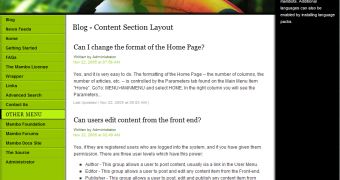The management of content over the web can be simplified at any level with the help of CMS (content management systems) applications. They are suitable both for beginners and advanced webmasters. The main role of a CMS is to separate the content creation from its presentation (website layout).
In this way, there are not necessary advanced notions regarding web related programming languages. You just have to select a CMS suitable for creation of a given website type, install it and then add content.
Mambo is a general purpose free application that runs on any operating system having PHP/MySQL support. It will give anyone the opportunity to create any type of website because it allows the extension of basic functionalities through various modules. Practically you can deploy a simple blog, a classified ads or a news website in a very short time, without the need of supplementary design or code modifications.
Mambo CMS can be easily installed on Windows operating system if you have an Apache web server with support for PHP applications and a MySQL server. You can perform separate installations for Apache, PHP and MySQL or to use the all-in-one software packages like WAMP or XAMPP. The automatic installer will perform all the operations needed to setup your Mambo based website.
After you finalize the installation, you can begin to explore the administration panel, which is a web browser based interface to the MySQL database, where all the content will be stored. The website appearance can be customized in a visual manner, like changing the menus items order, the number of columns in a template, modules positions inside the website layout and more. Any new extension may be installed using an automatic universal installer. The templates can be changed with a single mouse click with the help of Template Manager, available in the Site main menu. For advanced users, templates can be edited at the level of XHTML and CSS code directly from your web browser in the Mambo Administration panel.
The content will be structured in a logic manner by Sections and Categories. Static (X)HTML pages could also be created. For example, if you need to change your home page in a static one (because by default it is dynamic), you just have to make a new static page, then assign a new menu entry to it positioned on the first level in the menu hierarchy. Joomla! users will find Mambo CMS very easy to customize, because these two CMSs have many common points from the structure and functionality point of view. If you want to try the latest version of Mambo CMS, it can be downloaded from here.

 14 DAY TRIAL //
14 DAY TRIAL //